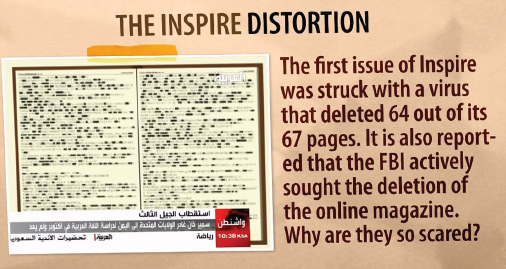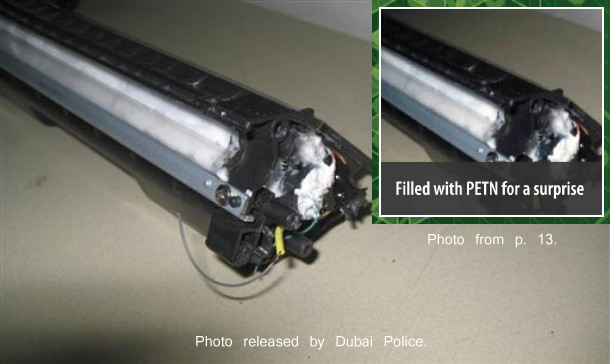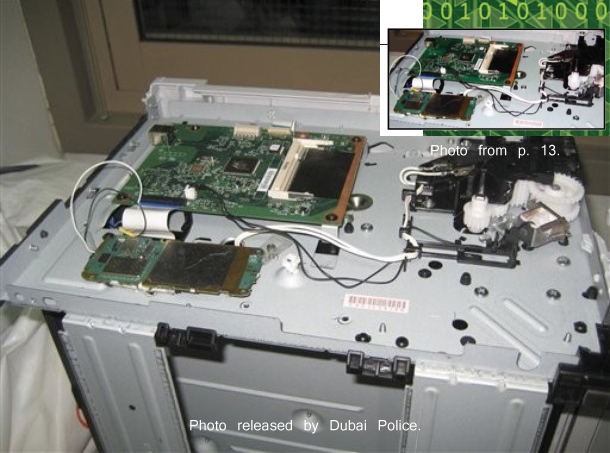Public Intelligence
With the release of their November 2010 Special Issue of Inspire magazine, a group claiming to be Al-Qaeda in the Arabian Peninsula (AQAP) has again succeeded in getting the entire global news media to uncritically relate their message. Every few months since the first release of the magazine in July 2010, the public is now subjected to a mass of uncritical stories that propagate predefined talking-points which are taken almost verbatim from one of two “monitoring groups” that actually profit from the sale of terrorist propaganda materials. One of those groups, the SITE Intelligence Group, was founded by the daughter of an executed Israeli spy. The other group, IntelCenter, is run by a former intelligence operative name Ben Venzke whose website offers a catalog to purchase Al-Qaeda videos, terrorist explosives manuals, and large, $30-40 terrorism-related wall charts. Despite this, many reporters do not seem to have been inspired enough to even examine the document in question. Joel Meares of the Columbia Journalism Review writes that when “Reading the latest terror reports it seems that any questions about the validity of Inspire have disappeared. The magazine once greeted with skepticism and perspective—to what extent one publication can speak for as disparate and fractured a community as the jihadists is always a question—is now being treated as the unquestioned and official spokes-journal of Al-Qaeda. And some close watchers of Al-Qaeda caution against the approach.”
From the initial release of the Summer 2010 issue of Inspire, we have expressed our doubts regarding the authenticity of these documents. With that initial release, which contained 64 pages of seemingly garbled text, we conclusively demonstrated that the file had not been corrupted by any virus, but had been deliberately spliced together with a book of cupcake recipes written by one Dulcy Israel. However, this received little attention. In fact, with the subsequent release of the second issue in October 2010, no one even seemed to note the anomalous cupcake origins of the document’s predecessor. They also failed to notice many other anomalies, such as the usage of material supposedly written by Osama Bin-Laden and Ayman al-Zawahiri, who are described by Max Fisher of the Atlantic as “extremely secretive” and usually issue statements “directly to the media”. Fisher concludes that “It would be unusual for them to write for a third-party publication, especially one put out by the Yemen-based AQAP, with which they have little or no direct ties.” Other oddities include the prominent use of a Desert Eagle handgun beneath the phrase “the dust will never settle” on page 25 of the first issue. The Desert Eagle is designed by Israeli Military Industries (now Israeli Weapons Industries) and manufactured in the United States. There is the difference in Al-Malahem logos first noted by Al-Jazeera’s Gregg Carlstrom. Moreover, there is the astoundingly overlooked fact that Jihadi forums openly described the magazine as a forgery that had been created by the “apostate hypocrit (sic) dogs who are trying to discredit the Mujahideens.”

In the image above, taken from page 7 of the second issue of Inspire, the magazine's authors reinforce the illusory belief that the first issue had been "struck with a virus".
The second issue of Inspire continued with these oddities, distorting the record of the first magazine by furthering the false impression that the first issue had been struck by a virus. On page 7 of the second Fall 2010 issue of Inspire, the creators claim that the “first issue of Inspire was struck with a virus that deleted 64 out of its 67 pages”. The writer then goes on to incorrectly reference an incident in late July when the FBI demanded the removal of a website from a hosting service that resulted in the take down of approximately 73,000 blogs. That incident was supposedly caused by materials related to the first issue of Inspire. The writer then asks “Why are they so scared?”
Understanding that the first issue of Inspire was not hit by a virus, but was instead spliced with a book of ASCII cupcake recipes, one must wonder why the producers of the magazine would aid the U.S. government and other authorities in perpetuating the myth that it was hit by a virus. Certainly, if an intelligence agency or other rogue entity had attacked a version of the magazine with cupcake recipes in the hopes of making AQAP look technically inept, that would make for excellent propaganda. However, we find that instead, the entity producing these publications is reinforcing an inaccurate view that the magazine was somehow “corrupted” by a virus. Given that the initial garbled version of Inspire was released on Jihadi forums in the form of links to dozens of temporary locations on file storage sites, the 64 pages of cupcake recipes must have been inserted prior to distribution. This conclusion is substantiated by the metadata in each of the original Inspire PDF files.
The first Inspire released with the cupcake recipes has the following timestamp:
2010-06-29 T16:50:27+01:00
The corrected version of the first issue of Inspire has the following timestamp:
2010-05-16 T16:58:51+03:00
This indicates that the original “complete” first issue of Inspire was created on May 16, 2010 and the “corrupted” version was created on June 29, 2010. Moreover, the corrupted version was created using a different program, PDFill rather than Adobe InDesign CS4, and was also created in the timezone for mainland Europe rather than Yemen. As this information is so easily accessible, substantial consideration must be given to the question of why the authors of Inspire would choose to support the fraudulent belief that the magazine had been attacked by a virus. The authors do not say that the release of the corrupted version was done by another group, implying instead that the file was somehow struck subsequent to its release. However, we know that this is not correct because there is no virus in the file and the garbled pages are cupcake recipes.
Who is Anwar al-Awlaki?
To understand some of the more fundamental reasons for doubting the authenticity of Inspire magazine, we must first examine the man whose group is supposedly producing the publication. Who is Anwar al-Awlaki? He was born in New Mexico and received his Master’s Degree from San Diego State University. He attended George Washington University until 2001 working on his doctorate. His father was a Fullbright scholar who received his doctorate from the University of Nebraska and worked at the University of Minnesota. According to CNN, the “al-Awlaki family comes from a large and powerful tribe in southern Yemen called the al-Awalek tribe. It has many connections to the government of Yemen, including the country’s prime minister, Ali Mohammed Mujawar, who is a relative of the family.”
Awlaki worked for the Department of Defense as part of their outreach towards the Muslim community following the attacks of September 11, 2001. In the months following the attacks he dined with “military brass” in the Army’s Office of Government Counsel. According to an employee that attended the luncheon, Awlaki was impressive and “condemned Al Qaeda and the terrorist attacks. During his talk he was ‘harassed’ by members of the audience and suffered it well.”
In the years following this meeting, Awlaki would reportedly become radicalized, eventually moving to Yemen to pursue jihad. However, according to the Los Angeles Times, many people in Yemen have never even heard about Awlaki. Many of those who area aware of him openly express their doubts about his authenticity. One person is quoted by the Times as saying “Al Qaeda is not real. They’ve been created for political reasons. We don’t know what’s going on or what exists and what doesn’t.”
In fact, Awlaki’s father also claims that the charges levied against his son are untrue. In a letter sent to President Obama about his son being placed on a CIA assassination list, Dr. Nasser Awlaki says that “My son is innocent, has nothing to do with violence and he is only a scholar of Islam and I believe that this has nothing to do with terrorism.”
The Packages Didn’t Come From Yemen
Following his supposed involvement with the Christmas Day “Underwear Bomber” Umar Farouk Abdulmutallab and the Fort Hood shooter Nidal Hassan, Awlaki’s most recent terror salvo involved sending packages containing explosive ink toner cartridges loaded inside normal-looking printers. This “Cargo Plot” has been the source of great anxiety for U.S. security officials, spurring increased security and screening measures across the U.S. However, according to several Yemeni shipping officials, the alleged packages containing the bombs did not come from Yemen. According to Fiaz Gazali, a senior security official at Sana’a airport, “There is no proof that the package came through the airport and I confirm that the package was not from Yemen. UPS or FedEx has not landed a single plane in our airports for a long time.”
In fact, the day of the attacks Mohammed al-Shaibah, Air Cargo Director for Yemenia Airways told the Yemen Post that “No UPS cargo plane left Yemeni lands over the land 48 hours. These accusations are false and baseless. No UPS or DHL cargo packages heading to Chicago through Yemen took place in the last 48 hours as well. All packages are checked very carefully in Yemen, and there is no evidence to prove that this package came through Yemen.”
According to Voice of America, the U.S. government and President Obama did not learn of the threat from these bombs until late in the evening on October 28. However, the Israeli Transporation Minister, Yisrael Katz has stated that Israel received warning of the plot to send bombs to U.S. synagogues at least a day before that. Katz said that “Since Thursday Israeli representatives have been on location in sensitive airports around the world, securing shipments to Israel” and that this was being conducted ahead of a “large-scale drill at Ben Gurion International Airport”.
Support for Screening
Due to the mass of uncritical reporting surrounding the most recent issue of Inspire, the magazine is playing a functional role in persuading public opinion in favor of increased security measures in the U.S. and around the world. By reinforcing the notion that there is a determined group in Yemen sending these package bombs, the magazine serves to bolster official support for invasive screening procedures. In fact, overwrought and overly-expensive security measures are exactly the group’s goal according to page 7 of the latest issue:
“The air freight is a multi-billion dollar industry. FedEx alone flies a fleet of 600 aircrafts and ships an average of four million packages per day. It is a huge worldwide industry. For the trade between North America and Europe air cargo is indispensable and to be able to force the West to install stringent security measures sufficient enough to stop our explosive devices would add a heavy economic burden to an already faltering economy. We knew that cargo planes are staffed by only a pilot and a co-pilot so our objective was not to cause maximum casualties but to cause maximum losses to the American economy. That is also the reason why we singled out the two U.S. air freight companies: FedEx and UPS for our dual operation.”
Interestingly enough, many of the passages are written from a perspective that appears to reinforce enhanced U.S. screening measures. For example, in an article about the “The Objectives of Operation Hemorrhage” written by the “Head of Foreign Operations” the group claims that “if both packages passed through the inspection at the FedEx and UPS facilities and passed through the X-Ray systems at the airport, that would raise a worldwide alert that would force upon the West two choices: You either spend billions of dollars to inspect each and every package in the world or you do nothing and we keep trying again. The packages not only made it out of Sana’a but one of them made it all the way to London and if it was not for an intelligence tip, both devices would have detonated.” Notice how the dichotomy in this statement is set up to reinforce the efficacy of screening procedures: either you screen everything or we keep trying, indicating that they would stop if effective screening measures were enacted.
Another passage dismisses metal detectors as “amateurish” while reinforcing the potential efficacy of X-ray screening equipment. In an article from the “Explosives Department” argues that “We have been blessed by Allah to be able to sidestep the metal detection equipment and this is evident in the operation of Umar Farouk and the operation of Abul Khayr, may Allah accept him. That capability was a result of avoiding the use of metals altogether in our detonators. We have developed five such detonators.” The writer goes on to very briefly describe the detection mechanisms that X-Ray scanners use and says “We have studied various X-Ray scanners that are in use and those that might be deployed in the future but are too expensive to deploy now. All these scanners work on one principle even if they are different. In the future, new scanners could be developed to designate specific colors for explosive material, but is this method practical?”
No Exclusive Photos
Despite the magazine’s claims on its cover and table of contents, the latest issue of Inspire does not contain images of the “bombs” before they were shipped to the United States. What the magazine does contain is pictures of a printer that is the same model and a copy of Charles Dickens’ Great Expectations. There are no photos of the inner, explosive components of the bomb or its preparation. This should not be hard to do considering the prevalence of equipment for taking digital photographs and the creators’ obvious intent to document their actions for propaganda purposes. In fact, the only pictures of the internal explosives and detonators come from photos released by the Dubai Police.
Different Logos
As was noted previously, the logos used for Inspire magazine in all of its versions are different than the traditional al-Malahem logo.
A Cold Diss
There are strange messages at the bottom of “advertisements” on pages 5,9, and 12. One of these messages describes the advertisement as being “brought to you by A Cold Diss.” Several similar messages have occurred in each of the first two magazines.
U.S. Email Addresses
Since the first issue of Inspire, the magazine has offered email addresses and a PGP key in order to contact them. These email addresses are:
inspire1magazine@hotmail.com
inspire11malahem@gmail.com
inspire22malahem@fastmail.net
inspire2magazine@yahoo.com
With such scrutiny on their activities, why would a terrorist organization openly publish four unchanging contact addresses that are all hosted on U.S. servers? Once the first magazine was released, it would require extremely minimal time to obtain a search warrant or conduct higher level NSA spying on the addresses. Jihadi groups often disseminate videos and other materials via U.S. file hosting services that serve as dropboxes. However, these only last for a short time before they are removed and they only allow for one way surveillance. That is, government sources could determine who is downloading the materials, but the potential targets of this surveillance could not interact with the dropbox. Why would a magazine designed to promote American Jihadism set up what is essentially a trap for those attempting to communicate with AQAP, ensuring that all messages are categorized, indexed, and readied for subpoena or monitoring under some higher, unknown precedent? Even if the messages are encrypted, as the magazine instructs that they should be, it still would lead to the leakage of identifying information such as IP addresses and other lesser known indicators. Moreover, the magazine is obviously intended for instructional purposes to an audience unfamiliar with such security measures. Also, it is worth noting that 2048 bit PGP keys are usually substantially longer than the one provided by Inspire.
Be Critical
In a recent piece from the Columbia Journalism Review discussing some of the highly uncritical coverage of the latest issue of Inspire magazine, Aaron Zelin, a research assistant at the Department of Politics at Brandeis and a blogger at Jihadology.net, is quoted as seeing a changing tone in the coverage of the magazine. “The media has taken the latest edition as truth instead of being critical of the information in it—outlets have been taking what they say as fact.”
With so much strangeness in these documents, with the cold disses, cupcake recipe sabotages, and ultimate mowing machines, we must continue to ask: does anyone take these al-Qaeda magazines seriously? Or perhaps, more properly, why would anyone take these al-Qaeda magazines seriously? Please tell us if you know.





